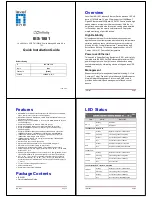
D-Link EasySmart Switch User Manual
34
QoS > 802.1p Default Priority
QoS is an implementation of the IEEE 802.1p standard that allows network administrators to reserve
bandwidth for important functions that require a larger bandwidth or that might have a higher priority, such as
VoIP (voice-over Internet Protocol), web browsing applications, file server applications or video conferencing.
Thus with larger bandwidth, less critical traffic is limited, and therefore excessive bandwidth can be saved.
The following figure displays the status of Quality of Service priority levels of each port, higher priority means
the traffic from this port will be first handled by the switch. For packets that are untagged, the switch will
assign the priority depending on your configuration.
Figure 274 – QoS > 802.1p Default Priority
Queuing Mechanism:
Select Strict Priority to process the packets with the highest priority first. Select WRR
(Weighted Round-Robin) to process packets according to the weight of each priority. When a priority level
has reached its egress weight, the system will process the packets in the next level even if there are
remaining packets. D-Link EasySmart Switch system’s weight of priority levels are: 8 (Highest), 4 (High), 2
(Medium) and 1 (Low) packet. By default, the queuing mechanism is
Strict Priority
.
QoS > Storm Control
The Storm Control feature provides the ability to control the receive rate of broadcast, multicast, and
unknown unicast packets. Once a packet storm has been detected, the Switch will drop packets coming into
the Switch until the storm has subsided.
Figure 285– QoS > Storm Control
Storm Control Type:
User can select the
different Storm type from Broadcast Only, Multicast & Broadcast,
and Multicast & Broadcast & Unknown Unicast.
Threshold (pps):
If storm control is enabled (by default it is disabled), the threshold can be set from 1 to
1,000,000pps.










































